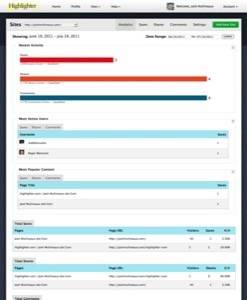
One of the longstanding laments about our move to digital literature is how difficult and cumbersome this makes marginalia, those notes and annotations we make in the margins of printed text. A story in The New York Times earlier this year went so far as to call the future of marginalia “dim,” not only due to our inability to write comments in the margins but because there’s not been any good system by which to track and preserve our notes.
TechStars alum Highlighter believe it has cracked this nut, with one line of JavaScript (inserted into site’s footer) that lets publishers enable marginalia on their websites and in turn allows visitors to highlight, annotate, save, and share passages and comments.
Of course, the ability to comment, per se, on websites isn’t new. But blog comments and the like always come at the end of a post, and likely means that readers would leave different sorts of notes and have different sorts of discussions with one another than if they could mark up a particular passage and make in-line comments there.
Annotations & Academics
That exercise in annotation is something most scholars and students are very familiar with, and no surprise Highlighter says it plans to market to this group specifically. By installing Highlighter on a class blog, for example, teachers will be able to enable commenting and highlighting by individual students and will also have a means to track students’ level of engagement with the text. Part of what publishers (and let’s use that word loosely here, after all, with blogs and Tumblr and the like, we’re almost all publishers now) get with Highlighter is analytics – the ability to see who’s reading, who’s highlighting and who’s sharing.

Visitors needn’t sign up for a Highlighter account in order to write marginalia and share highlights and comments. They do, however, need an account if they want to track and store their own annotations. With an account you can also choose to make your highlights and comments public, semi-public or private, meaning that you can share your notes openly or just with those in a particular group, or keep everything to yourself.
This sharing of notes and annotations is important, but it isn’t something that’s widely available or supported. Take Amazon Kindle highlights. There’s no way to share your notes with others. There’s no way to follow other readers (or authors) and see what interests them, what they’ve highlighted, and what notes they’ve jotted down. Highlighter solves that problem
Encouraging Engaged Readers –Something Teachers, Authors, and Publishers Alike Want
This social component is important in classroom reading, but it’s also great in general for building an engaged audience. Highlighter co-founder Josh Mullineaux says that authors, many of whom are increasingly turning to self-publishing efforts, will be able to take advantage of turning over sample chapters and the like to their fans, not just their editors, eliciting feedback not just on a whole piece, but on a word, a phrase, a paragraph.
Much like blog comments, publishers will be able to monitor comments and have a number of administrative controls so that comments and highlights must be pre-approved, for example, or that commenters are forced to give their name and email address before leaving or sharing notes.
Highlighter’s official launch today will bring it into competition with a number of other startups that are trying to tackle the problem of digital marginalia, including OpenMargin and Readum.










